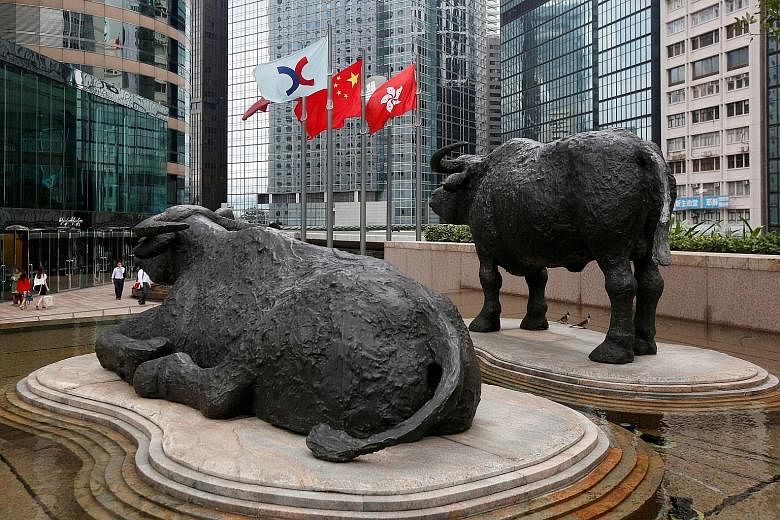The competition between the Singapore Exchange (SGX) and the stock exchange of Hong Kong for listings looks set to intensify as more companies here mull over moves to head to the Republic's rival to raise capital.
Market watchers said this reveals that a growing number of companies are hoping to deepen their business presence in the Greater China market, but these moves are not a guaranteed success.
As Osim prepares its initial public offering (IPO) in Hong Kong as V3 Group, news emerged earlier this month that Pan-United Corp is spinning off its Chinese port division for a Hong Kong listing, while LHN said it is eyeing a dual primary listing there.
Both SGX-listed, Pan-United is Singapore's largest ready-mixed concrete and cement supplier, and LHN is a real estate management firm.
MORE HEADING NORTH
The number of Singapore companies exploring a Hong Kong IPO has "doubled", according to PwC.
-
21 Number of newly listed companies on the Hong Kong stock exchange mainboard in the first quarter of this year.
1 Number of newly listed companies on the SGX mainboard in the first quarter of this year - Dasin Retail Trust's $121 million IPO.
"Looking at our pipeline, I would say, over the past 12 months, the number of Singapore companies considering a Hong Kong IPO has doubled to over a dozen," PwC capital markets services leader Tham Tuck Seng said.
"They are a mixture of SGX-listed firms and private companies mainly in the manufacturing and trading sectors.
"They are choosing Hong Kong because they are setting up factories in China or trying to penetrate that market. So Hong Kong makes more sense because being there gives them better brand visibility and consumer trust in their target market," he said.
Osim, which was delisted from SGX last year, operates some 172 stores in mainland China and 35 in Hong Kong, compared with just 26 here. Company head Ron Sim is also said to be unhappy about the valuation levels on the SGX.
"Valuations and liquidity are indeed another pull factor, and the perception by some is that Hong Kong listings ensure better valuations. Companies also like to be in a more active market where they can keep raising funds with ease," Mr Tham said.
NOT EITHER OR
The fight for listings between Singapore and Hong Kong is frequently brought up as the SGX comes under scrutiny - and the numbers may look somewhat one-sided at a glance.
In the first quarter of this year, the Hong Kong stock exchange mainboard had 21 newly listed companies and HK$13.4 billion (S$2.4 billion) in equity funds raised. The SGX mainboard had only one - Dasin Retail Trust's $121 million IPO.
But DBS capital markets head Eng-Kwok Seat Moey does not see a win-lose competition between the two.
"I do see a rising trend of corporate M&As (mergers and acquisitions), but any delistings - which are inevitable in the case of full acquisitions - do not mean that there's a preference for Hong Kong," Mrs Eng-Kwok said.
"In fact if you look at Hong Kong's performance, the funds raised in IPOs last year dropped from 2015, and for the first quarter this year it's also been half of that in the same period last year. In contrast, Singapore's performance has been improving," she added.
Hong Kong reported 126 IPOs last year but the HK$195.3 billion raised was down 26 per cent from 2015.
On the SGX, last year there were 16 IPOs raising some $1.8 billion, up from $339 million in 2015.
And, Mrs Eng-Kwok expects further recovery: "Last year, DBS did four out of the five mainboard listings and quite a number of Catalist listings on the SGX. This year, (the pipeline) seems just as healthy."
NOTHING GUARANTEED
Ultimately, getting listed in either Hong Kong or Singapore will have its share of challenges and opportunities.
Not all companies that have departed the SGX have achieved much better valuations in Hong Kong.
Watch company Time Watch was delisted from SGX in 2011 at a price-to-earnings (PE) ratio of about five. After a Hong Kong IPO, its PE ratio now stands at about eight - a modest improvement at best.
Luye Pharma, which was delisted from SGX in 2012 and relisted in Hong Kong, had a PE ratio of about 19 then, but this has fallen to about 15 now.
Food company Want Want's current PE ratio of 17 in Hong Kong is also lower than its PE ratio of 21 when it left the SGX in 2007.
Mr Tham said the valuation of a stock is more often the reflection of a company's earnings and business performance, not where it is listed.
He added: "The ones that are looking to go there are mostly medium-sized companies, and the Hong Kong market has a sea of these, particularly in the traditional sectors like manufacturing, consumer and trade. You can get buried just as easily as you stand out."


